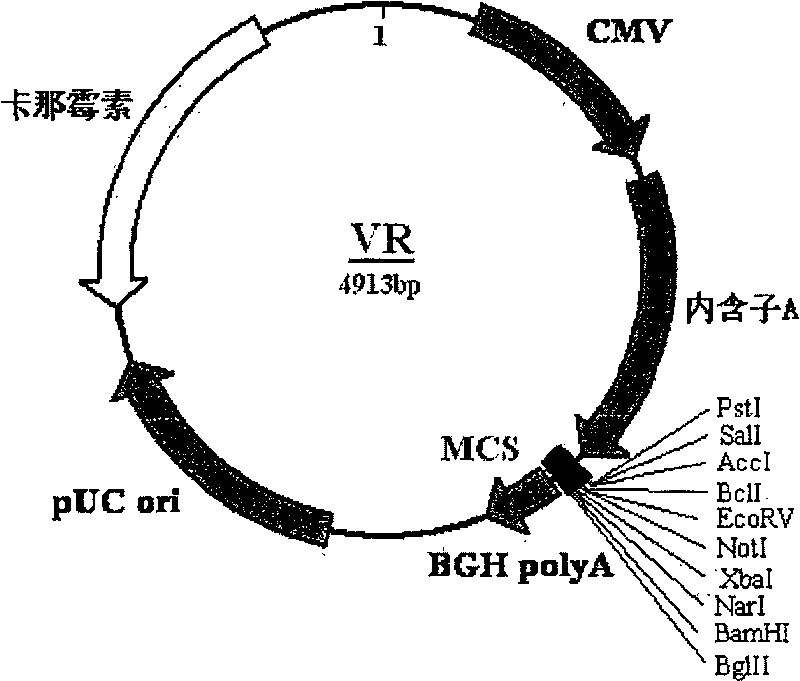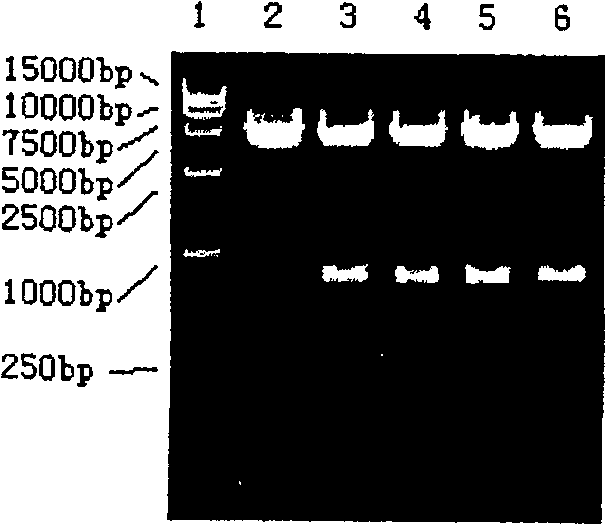Modified HPV E6-E7 fusion gene and coding protein thereof
A HPV16E6-E7, fusion gene technology, applied in the field of fusion genes and their encoded proteins
- Summary
- Abstract
- Description
- Claims
- Application Information
AI Technical Summary
Problems solved by technology
Method used
Image
Examples
Embodiment 1
[0040] Codon optimization of HPV16 E6E7
[0041] In order to increase the expression of the HPV16 E6E7 gene in mammalian cells, especially human cells, codon optimization was performed on the HPV16 E6E7 gene in this embodiment.
[0042] According to the partial tropism of human gene codons, a codon-optimized HPV16 E6E7 fusion gene was designed by using the most frequently used codons and the second most frequently used codons in human genes, named ofE6E7, and its encoded amino acid sequence contains the complete wild-type The amino acid sequences of HPV16 E6 protein (Genebank ACCESSION: AAA46939) and E7 protein (Genebank ACCESSION: AAA46940) are directly fused with the amino acid sequence of E6 protein at the amino terminal and the amino acid sequence of E7 protein at the carboxyl terminal, wherein the amino acid sequence of E6 protein is The 136th arginine and the 32nd seramino in the amino acid sequence of the E7 protein use the codons AGG and TCC, which are the second most ...
Embodiment 2
[0045] Synthetic codon-optimized HPV16 E6E7 fusion gene
[0046] In this example, the ofE6E7 gene described in Example 1 was spliced and synthesized by overlapping extension PCR (overlap extension PCR, OE PCR).
[0047] Primer design
[0048]Referring to the codon-optimized nucleotide sequence ofE6E7, 10 long-chain primers (A1, A2, B1, B2, C1, C2, D1, D2) with a length of about 89 oligonucleotides containing overlapping sequences were designed and synthesized. ), and 10 short-chain primers (p1, p2, p2, p4, p5, q1, q2, q3, q4, q5) that are used to connect these long-chain primers with a length of about 25 oligonucleotides, of which Two short-chain primers (p1 and q10) contain restriction enzymes Kpn I and Xba I cutting sites. The primers were synthesized by entrusting Beijing Qingke Biotechnology Co., Ltd., soluble in ddH 2 In O, the concentration of long-chain primers was 10 μmol, and the concentration of short-chain primers was 25 μmol. The primer sequences are shown i...
Embodiment 3
[0060] Embodiment 3: Site-directed mutagenesis of ofE6E7 gene
[0061] In this embodiment, site-directed mutagenesis is performed on the obtained optimized fusion HPV16 E6E7 gene ofE6E7 gene to prepare a codon-optimized mutant HPV16 E6E7 fusion gene to eliminate the carcinogenicity of the HPV16 E6E7 gene to eliminate the carcinogenicity of the HPV16 E6-E7 fusion gene .
[0062] Specifically, in the amino acid sequence part of the E6 protein: 57Leu(CTG)→Gly(GGC) and 113Cys(TGC)→Arg(AGA), in the amino acid sequence part of the E7 protein: 24Cys(TGC)→Gly(GGC), 26Glu (GAG)→Gly(GGC), 58Cys(TGC)→Gly(GGC) and 91Cys(TGC)→Gly(GGC). The corresponding residue positions of L57G, C113R of the above-mentioned E6 protein and C24G, E26G, C58G, and C91G of the E7 protein in the amino acid sequence of the fusion protein (E6 is at the 5' end, and E7 is at the 3' end) are: L57G, C113R, C182G, E184G, C216G, and C249G. In this example, three kinds of codon-optimized fusion genes after site-direc...
PUM
 Login to View More
Login to View More Abstract
Description
Claims
Application Information
 Login to View More
Login to View More - R&D
- Intellectual Property
- Life Sciences
- Materials
- Tech Scout
- Unparalleled Data Quality
- Higher Quality Content
- 60% Fewer Hallucinations
Browse by: Latest US Patents, China's latest patents, Technical Efficacy Thesaurus, Application Domain, Technology Topic, Popular Technical Reports.
© 2025 PatSnap. All rights reserved.Legal|Privacy policy|Modern Slavery Act Transparency Statement|Sitemap|About US| Contact US: help@patsnap.com



